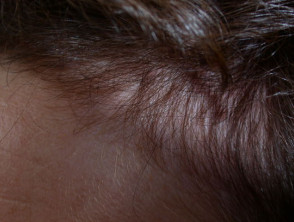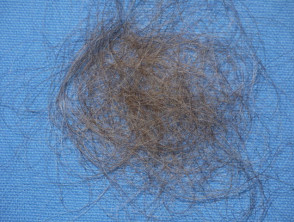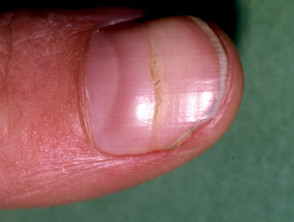What is telogen effluvium?
Telogen effluvium is the name for a common cause of temporary hair loss due to the excessive shedding of resting or telogen hair after some shock to the system. New hair continues to grow. Telogen hair is also known as a club hair due to the shape of the root.
It should be distinguished from anagen effluvium, in which the hair shedding is due to interruption of active or anagen hair growth by drugs, toxins or inflammation (eg, alopecia areata). Anagen hair has a pointed or tapered tip.
Telogen effluvium
Who gets telogen effluvium?
Acute telogen effluvium can affect people of all age groups and both sexes. Chronic telogen effluvium with no clear precipitating cause tends to present in otherwise healthy women 30–60 years of age.
What is the cause of telogen effluvium?
In a normal healthy person's scalp, about 85% of the hair follicles are actively growing hair (anagen hair) and about 15% are resting hair (telogen hair). A few hairs may also be in catagen. A hair follicle usually grows anagen hair for 4 years or so, then rests for about 4 months. A new anagen hair begins to grow under the resting telogen hair and pushes it out.
Thus, it is normal to lose up to about 100 hairs a day on one's comb, brush, in the basin or on the pillow, as a result of the normal scalp hair cycle.
If there is some shock to the system, as many as 70% of the anagen hairs can be precipitated into telogen, thus reversing the usual ratio. Typical triggers include:
- Childbirth: postpartum hair loss. This can resolve after a few months or transition into female pattern alopecia.
- Physiological neonatal hair loss
- Acute or chronic illness, especially if there is fever
- Surgical operation
- Accident
- Psychological stress
- Weight loss, unusual diet, or nutritional deficiency (eg, iron deficiency/)
- Certain medications
- Endocrine disorders (eg, hypothyroidism, hyperthyroidism)
- Discontinuing the contraceptive pill
- Overseas travel resulting in jetlag
- Skin disease affecting the scalp (eg, erythroderma)
- Excessive sun exposure.
What are the clinical features of acute telogen effluvium?
Telogen effluvium is a non-scarring form of diffuse hair loss with no clinical or histological evidence of inflammation and can affect up to 50% of the scalp hair.
The resting scalp club hairs remain firmly attached to the hair follicles at first. The new hairs coming up through the scalp push out the resting club hairs and increased hair fall is noticed 2 to 4 months after the triggering event.
Thus, paradoxically, with this type of hair loss, hair fall is a sign of hair regrowth.
- As the new hair first comes up through the scalp and pushes out the dead hair, a fine fringe of new hair is often evident along the forehead hairline.
- At first, the fall of club hairs is profuse and a general thinning of the scalp hair may become evident but after several months a peak is reached and hair fall begins to lessen, gradually tapering back to normal over 6–9 months in most cases.
- As the hair fall tapers off, the scalp thickens back up to normal, but recovery may be incomplete in some cases.
Because nail and hair growth are under the same influences, an arrest in hair growth is often mirrored in the nails by a groove across them coinciding with the time of the shock to the system — a Beau line. The time of the shock can be estimated from the fact that a fingernail takes 5 months to grow from the posterior nail fold to the free edge. So if the groove in the nail is halfway down the nail, the shock must have been two and a half months ago.
Beau line
Chronic telogen effluvium
In some patients, hair shedding continues to be intermittently or continuously greater than normal for long periods of time, sometimes for years. The hair cycle appears to be reset so that the anagen period is shortened.
Chronic telogen effluvium often presents in women that actually continue to have quite thick and moderately long hair – this is because they notice the shed hair more than those with finer or shorter hair. Telogen effluvium does not cause complete baldness, although it may unmask a genetic tendency to genetic balding i.e. female pattern hair loss, or in men, male pattern hair loss.
The mechanism of chronic telogen effluvium is not well understood. Middle-aged women with a long fluctuating course of telogen effluvium, producing widespread thinning lasting many years have normal hormonal studies.
How is telogen effluvium diagnosed?
Telogen effluvium is usually diagnosed by its clinical features.
- Hair thinning involves the entire scalp +/- loss of other body hair.
- Examination shows diffuse thinning without focal areas of total alopecia and short hairs of normal thickness.
- A gentle hair pull test reveals an increased number of hairs; most are telogen with a typical epithelial sac.
A trichogram can help confirm the diagnosis; more than 25% telogen hairs in a trichogram strongly suggests telogen effluvium.
Light microscopic examination shows club hair
A scalp biopsy is rarely needed; it is expected to show normal terminal/vellus hair ratio, an increased number of telogen follicles, and little to no inflammation and fibrosis.
What is the differential diagnosis for telogen effluvium?
Other forms of hair loss that should be considered include:
- Female pattern hair loss (look for a widened part and thinner hair on the anterior and vertex of the scalp)
- Male pattern hair loss (as a bi-temporal recession is sometimes seen in telogen effluvium).
- Diffuse alopecia areata (look for associated immune phenomena, eg, vitiligo). Scalp biopsy will show a lymphocytic perifollicular infiltrate
- Anagen effluvium (which tends to be more severe than telogen effluvium)
- Defects of the hair shaft including loose anagen hair syndrome
- Congenital atrichia
- Congenital hypotrichosis
What is the treatment for telogen effluvium?
Telogen effluvium is self-correcting. Recommendations include:
- Gentle handling of the hair, avoiding over-vigorous combing, brushing and any type of scalp massage
- Treat any underlying scalp disorder or hormonal problem determined, if any
- Ensure a nutritious diet, with plenty of protein, fruit and vegetables.
- Correct any abnormality in thyroid function, or levels of iron, vitamin B12 and folic acid.
The psychological effects of hair loss should not be ignored.
What is the outcome for telogen effluvium?
Regrowth usually occurs after removal of the trigger causing telogen effluvium. However, repeated episodes of acute telogen effluvium can sometimes evolve into female pattern hair loss.





